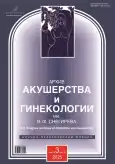Применение тулиевого лазера для удаления полипов эндометрия у пациенток репродуктивного возраста
- Авторы: Доброхотова Ю.Э.1, Лапина И.А.1,2, Аллахвердиева А.Р.1,2, Кайкова О.В.2
-
Учреждения:
- Российский национальный исследовательский медицинский университет им. Н.И. Пирогова
- Клиническая больница № 2 «Медси»
- Выпуск: Том 12, № 3 (2025)
- Страницы: 326-334
- Раздел: Оригинальные исследования
- URL: https://bakhtiniada.ru/2313-8726/article/view/350245
- DOI: https://doi.org/10.17816/aog677985
- EDN: https://elibrary.ru/NNMLYD
- ID: 350245
Цитировать
Аннотация
Обоснование. Эндометриальные полипы — распространённая гинекологическая патология, встречающаяся у 10–24% женщин репродуктивного возраста, часто приводящая к бесплодию и нарушению менструального цикла. Одним из эффективных методов удаления полипов является биполярная резекция, однако она сопровождается значительным болевым синдромом и длительным восстановлением. Из более эффективных и менее болезненных методов перспективным направлением считается применение тулиевого лазера, который успешно зарекомендовал себя в современной урологической практике.
Цель. Оценить эффективность и безопасность применения тулиевого лазера при полипэктомии у пациенток репродуктивного возраста.
Методы. В исследовании, включавшем 46 женщин с эндометриальными полипами (по 23 в каждой группе), сравнивали два метода полипэктомии: тулиевый лазер и биполярную резекцию. Учитывали время процедуры, уровень боли, сроки восстановления менструаций, частоту рецидивов и приемлемость.
Результаты. Выявлено, что тулиевый лазер обеспечивает более короткую длительность операции (10,04±0,97 мин против 13,86±1,2 мин), меньший болевой синдром, более быстрое восстановление менструальной функции (28,6±2,9 дня против 34,65±3,06 дня) и более низкую частоту рецидивов (8,69 против 17,39%). Приемлемость тулиевого лазера для пациенток также оказалась выше (99,39 против 92,39% через 1 мес.).
Заключение. Полученные результаты указывают на преимущество тулиевого лазера в лечении эндометриальных полипов и необходимость дальнейших исследований для оценки долгосрочных эффектов.
Полный текст
Открыть статью на сайте журналаОб авторах
Юлия Эдуардовна Доброхотова
Российский национальный исследовательский медицинский университет им. Н.И. Пирогова
Email: Pr.Dobrohotova@mail.ru
ORCID iD: 0000-0002-7830-2290
SPIN-код: 2925-9948
д-р мед. наук, профессор
Россия, 117997, Москва, ул. Островитянова, д. 1Ирина Александровна Лапина
Российский национальный исследовательский медицинский университет им. Н.И. Пирогова; Клиническая больница № 2 «Медси»
Автор, ответственный за переписку.
Email: doclapina@mail.ru
ORCID iD: 0000-0002-2875-6307
SPIN-код: 1713-6127
д-р мед. наук
Россия, 117997, Москва, ул. Островитянова, д. 1; МоскваАйшан Рагим Аллахвердиева
Российский национальный исследовательский медицинский университет им. Н.И. Пирогова; Клиническая больница № 2 «Медси»
Email: allakhverdievaayshan@gmail.com
ORCID iD: 0000-0001-8693-5867
SPIN-код: 3958-5660
Россия, 117997, Москва, ул. Островитянова, д. 1; Москва
Олеся Владимировна Кайкова
Клиническая больница № 2 «Медси»
Email: kajkova.ov@medsigroup.ru
ORCID iD: 0009-0007-3931-5762
Россия, Москва
Список литературы
- Clinical Guidelines “Endometrial Polyps” (approved by the Ministry of Health of the Russian Federation). Russian Society of Obstetricians and Gynecologists. Moscow, 2023. 32 p. (In Russ.) URL: http://disuria.ru/_ld/12/1289_kr23N84p0MZ.pdf
- Orazov MR, Khamoshina MB, Poimanova OF, et al. Clinical and anamnestic factors of recurrent endometrial polyps in fertile age. Clinical Review for General Practice. 2023;4(9):31–35. doi: 10.47407/kr2023.4.9.00305 EDN: FFVZCF
- Safronov OV, Kazachkova EA, Kazachkov EL, et al. Prevalence rate and structure of minimally invasive surgical intrauterine pathology in the light of pathomorphosis theory. Ural Medical Journal. 2020;(3):65–70. doi: 10.25694/URMJ.2020.03.38 EDN: UOFLIO
- Khusid JA, Khargi R, Seiden B, et al. Thulium fiber laser utilization in urological surgery: A narrative review. Investig Clin Urol. 2021;62(2):136–147. doi: 10.4111/icu.20200467
- Rice P, Somani BK. A systematic review of thulium fiber laser: applications and advantages of laser technology in the field of urology. Res Rep Urol. 2021;13:519–527. doi: 10.2147/RRU.S233979
- Noureldin YA, Kallidonis P, Liatsikos EN. Lasers for stone treatment: how safe are they? Curr Opin Urol. 2020;30(2):130–134. doi: 10.1097/MOU.0000000000000706
Дополнительные файлы













